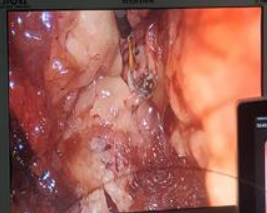Laparoscopic pyeloplasty through transperitoneal access – operative results of the first 12 cases in our practice
Keywords:
Laparoscopic surgery, pyeloplasty, stenosis of the PUS, transperitoneal accessAbstract
Summary
Objective: To present our initial experience of the 12 cases performed with laparoscopic transperitoneal pyeloplasty in patients with obstruction of the pyeloureteral segment.
Materials and methods: For the period from 2022 to the beginning of 2024- total of 12 laparoscopic surgical interventions were performed on patients with obstruction of the pyeloureteral segment(UPJ) through transperitoneal access. The patients were 8 women and 4 men. Regarding the age indicator, the patients were in an active, "young" age, between 25 years and 49 years. For diagnosis preoperatively we used a computer tomographic examination of the abdomen and pelvis with intravenous contrast material and an excretory urographic phase.A double JJ stent was placed before the pyeloplasty. Regarding the cause of the obstruction,in 4 patients we diagnosed the presence of an aberrant vessel,in the remaining 8 we had a stenosis of the UPJ and in two we had a kidney stone in the pyelon of the kidney.
Methods: For the treatment of UPJ we performed a laparoscopic transperitoneal pyeloplasties.The patients were operated on by one operative team with operator Dr. S. Stanimirov in two hospitals. Accordingly, 9 patients were operated on in the "St. Anna" Hospital - city of Varna and 3 patients in University Hospital "Deva Maria" - city of Burgas. The team had previous laparoscopic experience in kidney and prostate surgery. Considering that to start laparoscopic pyeloplasty, it is necessary to have enough acquired laparoscopic experience. The operative team was composed of operator, assistant and operating nurse. All patients were under general intubation anesthesia. The patient was placed in a lateral position on the operating table. In all patients, the Hasson’s method was used to place the optical laparoscopic port. Two 10mm trocars were used and two 5mm. 0 degrees optics were used in the first 9 operative interventions and 30 degrees in the last 3 patients. We used the following laparoscopic instrument set: bipolar clamp - Johan type, ultrasonic scissors - Ultrasision type, monopolar scissors, dissector, grasper, needle holders. For the suture, we used an interrupted suture, with thread 3-0, slow resorption, needle ½, 19-21mm. Working pressure of CO2-12mm.Hg.
Conclusion:Laparoscopic transperitoneal pyeloplasty is possible for our team. The initial results are encouraging and we can expect them to improve as the number of cases progresses.
Downloads
References
Stanimir Stanimirov, volume 2, issue 1/2022, ISSN: 2738-778X, Clinical Urology.
Lau, Leow, Li 1997: 444 – 453.
Loffer FD, Pent D. Indications, contraindications and complications of laparoscopy. Obstet Gynecol Surv. 1975 Jul;30(7):407-27. doi: 10.1097/00006254-197507000-00001. PMID: 124409.
Wittmoser R (1973) Die Retroperitoneoskopie als neue Methode der lumbalen Sympathektomie. Fortschr Endosk 4:219–233
Gauer D (1992) Laparoscopic operative retroperitoneoscopy: Use of a new device. J Urol 148:1137–1139
Cv. Genadiev, D. Gaidarov, V. Veleva, PNEUMOPERITONEUM IN UROLOGY LAPAROSCOPIC OPERATIONS, BMJ.7.
El-Shazly MA, Moon DA, Eden CG. Laparoscopic pyeloplasty: status and review of literature. J Endourol.2007 Jul;21(7):673-8. doi: 10.1089/end.2007.9952. PMID: 17705747.
Inagaki T, Rha KH, Ong AM, Kavoussi LR, Jarrett TW. Laparo-scopic pyeloplasty: Current status. BJU Int 2005;95(suppl 2):102.
Turk IA, Davis JW, Winkelmann B, et al. Laparoscopic dismem-bered pyeloplasty: The method of choice in the presence of an en-larged renal pelvis and crossing vessels. Eur Urol 2002;42:268.
Zhang X, Li HZ, Ma X, et al. Retrospective comparison of retroperitoneal laparoscopic versus open dismembered pyeloplasty for ureteropelvic junction obstruction. J Urol 2006;176:1077.
Soulie M, Salomon L, Patard JJ. Extraperitoneal laparoscopic pyeloplasty: A multicenter study of 55 procedures. J Urol 2001;166:48.
Janetschek G, Peschel R, Franscher F. Laparoscopic pyeloplasty.Urol Clin North Am 2000;27:695.
Rassweiler JJ, Subotic S, Feist-Schwenk M, Sugiono M, Schulze M, Teber D, Frede T. Minimally invasive treatment of uretero-pelvic junction obstruction: Long term experience with an algo-rithm for laser endopyelotomy and laparoscopic retroperitoneal pyeloplasty. J Urol 2007;177:1000.
Moon DA, El-Shazly MA, Chang CM, Gianduzzo TR, Eden CG. Laparoscopic pyeloplasty: Evolution of a new gold standard. Urol-ogy 2006;67:932.

Downloads
Published
How to Cite
Issue
Section
License
Copyright (c) 2024 Clinical Images and Case Reports

This work is licensed under a Creative Commons Attribution 4.0 International License.
Clinical Images and Case Reports












